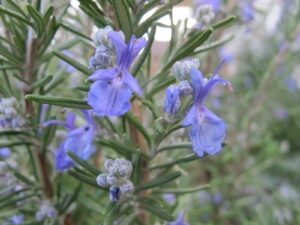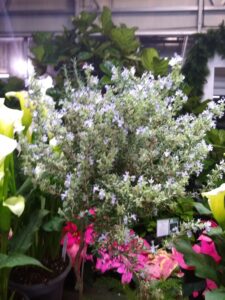 I went to Chincoteague Island, Virginia, last week to relax for a few days and see the wild horses made famous in author Marguerite Henry’s 1947 book Misty of Chincoteague. I caught sight of some of the horses, along with a wide variety of shore birds, wildflowers and gorgeous ocean scenery. It was inspiring and relaxing, but my inner gardener was most excited by the rosemary plants that I saw growing rampant in home gardens along Chincoteague’s Main Street.
I went to Chincoteague Island, Virginia, last week to relax for a few days and see the wild horses made famous in author Marguerite Henry’s 1947 book Misty of Chincoteague. I caught sight of some of the horses, along with a wide variety of shore birds, wildflowers and gorgeous ocean scenery. It was inspiring and relaxing, but my inner gardener was most excited by the rosemary plants that I saw growing rampant in home gardens along Chincoteague’s Main Street.
Many of us in cold winter climates grow rosemary for its value as a culinary herb and its lovely presence in the garden. But when temperatures start to hover around freezing, the plants have to come inside or they will die. If you have a warm greenhouse or an exceptionally sunny indoor space, your rosemary will flourish. If your living space does not include either of those things, you have to treat rosemary as an annual.
This was clearly not the case in Chincoteague, which has relatively mild winters, and lies in USDA plant hardiness Zone 8a. The plants that I saw were in full bloom, with bee-laden, early April blossoms in lighter or darker blue. The shrubs were three or four feet tall and equally wide—mature, well-established plants, thriving in an environment with sandy soil and sea-salted air. The blue blooms complemented the blue of the nearby ocean, reminding me that the Latin species name, “rosmarinus”, means “dew of the sea”.
Not surprisingly, rosemary, known botanically as Salvia rosmarinus or Rosmarinus officinalis, is native to areas around the Mediterranean. It is a member of the large and useful mint or Lamiaceae family, residing in the same genus as culinary and ornamental sages. Unlike most of those plants, rosemary is a shrub with woody, upright stems and green or gray-green, needle-like leaves. Young plants on display at the garden center might easily be mistaken for young English lavender plants. However, the clean sweet scent of lavender is decidedly different from the pungent aromatic fragrance of rosemary. In areas where rosemary survives outside year round, the shrubs can grow as tall as six or seven feet high, but can also be kept clipped to make them shorter and shapelier.
I have also seen sprawling specimens, like ‘Prostratus’ installed in terraced beds and allowed to froth over the sides to great effect.
The abundant spikes of tiny blue flowers on the Chincoteague rosemary were so compelling that I decided that I had to have at least one—in a large container—for my garden. Fortunately rosemary plants are not expensive, and are beginning to appear on garden center pallets, along with many other culinary herbs.
All blue is attractive to me, but I was drawn to the darkest blue of the Chincoteague plants. To get that dark hue in my own garden, I will search out varieties like ‘Tuscan Blue’, and upright form that has the potential to reach six feet in height and four feet wide. I suspect that those dimensions will be considerably less when I grow the plant in a large container. ‘Herb Cottage’, another dark blue-flowered variety, is somewhat smaller by nature, topping out at two to three feet tall and two feet wide.
For lighter blue flowers, try time-honored ‘Arp’, which allegedly will survive to USDA Zone 6, and is the most cold-tolerant of the commercially available varieties. Woody plant expert Michael Dirr, says that the tiny flowers smell like lemon.
If you are in full “Barbie” mode and fancy something pink and fragrant, try ‘Majorca Pink’, which grows three to four feet tall and about two feet wide.
If you are in the market for something smaller and are not committed to blue flowers, try ‘Lady in White’, with white blooms and a height and spread of about two feet.
Rosemary is versatile in the landscape and the kitchen. Planted in-ground, the shrubs make excellent single specimens, or can be grown as hedges and sheared or not, according to your inclination. The plants can function equally well in dedicated herb gardens or mixed annual and perennial beds. Deer and other creatures stay away, as they do from most mint family relatives. Rosemary tolerates drought, once plants are established, but hates heavy, wet soil. When you plant, amend the garden soil or potting mix with organic material and don’t overwater.
People who have read or seen Shakespeare’s Hamlet, either by choice or school requirement, will remember that in Act IV, Ophelia says, “There’s rosemary, that’s for remembrance.” The herb has many literary and historical connotations, and an equally large number of contemporary applications. If any of those aspects intrigue you, try Digging Dog Nursery, 31101 Middle Ridge Road, Albion, CA 95410: Tel. (707) 937-1130; www.diggingdog.com.

